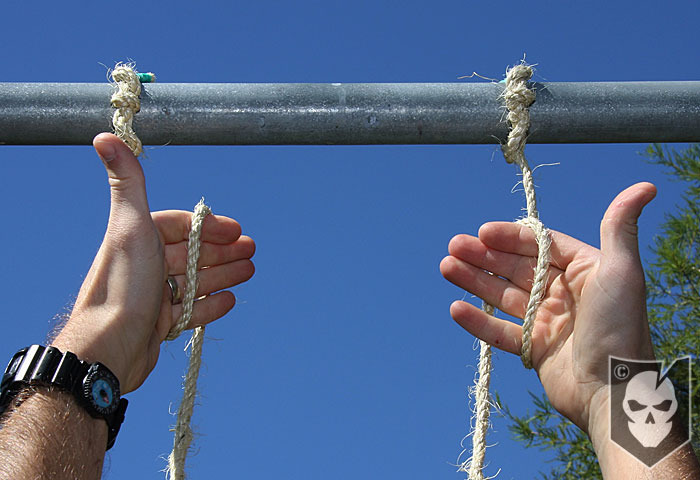Make a rope ladder
Make a rope ladder using rope and dowels, learn measuring and knot tying skills, test its strength safely with adult supervision.


Step-by-step guide to make a rope ladder
DIY Rope Ladder: Simple Steps to Create a Functional Climbing Aid
Step 1
Gather all materials and bring them to a clear flat workspace.
Step 2
Lay the two ropes side by side on the floor with ends even.
Step 3
Decide how far apart you want each rung to be (8–12 inches is a good choice).
Step 4
Use the tape measure to mark the first rope at each rung position from one end using the marker.
Step 5
Match and mark the same positions on the second rope so both ropes have identical marks.
Step 6
Place a dowel between the two ropes at the first pair of matching marks.
Step 7
Tie a tight overhand knot with the first rope around the end of the dowel to hold it in place.
Step 8
Tie a tight overhand knot with the second rope around the other end of the dowel to secure the rung.
Step 9
Repeat placing a dowel and tying knots for each remaining pair of marks until all rungs are in place.
Step 10
Trim excess rope tails close to each knot with scissors leaving a small tail for safety.
Step 11
Smooth any rough dowel ends lightly with sandpaper so they are safe to touch.
Step 12
Check every knot and rung by giving each one a firm tug to make sure they do not slip.
Step 13
With an adult, attach the ladder low to a strong anchor point using a secure knot the adult approves.
Step 14
With adult supervision, test the ladder’s strength by gently adding weight one step at a time.
Step 15
Share a photo and description of your finished rope ladder on DIY.org.
Final steps
You're almost there! Complete all the steps, bring your creation to life, post it, and conquer the challenge!

Help!?
What can we use if we can't find dowels or climbing rope?
If wooden dowels are hard to find, use short sections of sturdy PVC pipe or trimmed broom handles as rungs and replace thin cord with strong nylon or climbing rope, with an adult checking the chosen rope before tying the overhand knots.
What if the rungs keep slipping or knots come loose?
If rungs slip after you 'tie a tight overhand knot', retie using a double overhand or constrictor knot, wrap the dowel ends with tape before knotting, and then follow the instruction to give each rung a firm tug to recheck security.
How can we adapt the ladder for younger or older kids?
For preschoolers, make a short ladder with closer 6–8 inch spacing, use pre-cut dowels and have an adult do the overhand knots and attach the ladder low to a strong anchor, while older kids can measure, mark with the marker and tape measure, and tie each knot themselves.
How can we make the ladder look nicer or stronger?
To personalize and strengthen the ladder, lightly sand and paint each dowel after smoothing, wrap each rung end with colored electrical tape for extra grip before trimming tails, and add a name tag or decorative knots prior to sharing your photo on DIY.org.
Watch videos on how to make a rope ladder
DIY Wooden Rope Ladder - Easy Backyard Adventure!
Facts about knot-tying and basic woodworking for kids
📏 For kids, rung spacing around 12 inches (about 30 cm) is comfortable — careful measuring keeps climbing safe and fun.
💧 Natural-fiber ropes (like hemp) can weaken when wet, while synthetic ropes (like nylon) usually stay stronger and drier.
🪜 Rope ladders have been used on ships and in rescues for centuries — sailors and adventurers relied on them for quick climbs.
🪢 The square knot and clove hitch are two common, easy-to-learn knots used to tie dowels onto a rope ladder.
👷♀️ Always test a homemade ladder slowly with an adult present — aim for a safety factor (able to hold 5× the expected weight) during checks.
How do you make a rope ladder?
What materials do I need for a rope ladder?
What ages is this rope ladder activity suitable for?
What are the safety tips and variations for testing a homemade rope ladder?


One subscription, many ways to play and learn.
Only $6.99 after trial. No credit card required



